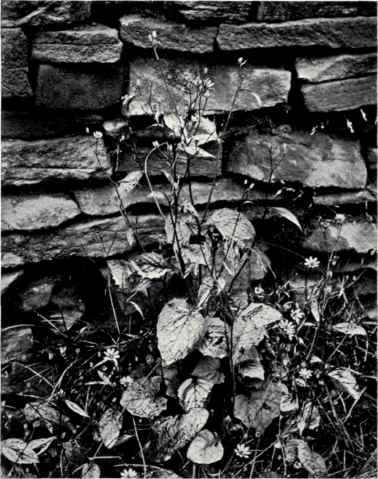Nipplewort (Lapsana Communis, L.)
Description
This section is from the book "British Wild Flowers - In Their Natural Haunts Vol2-4", by A. R. Horwood. Also available from Amazon: A British Wild Flowers In Their Natural Haunts.
Nipplewort (Lapsana Communis, L.)
Every hedgerow has its complement of Nipplewort, growing in rows, and it is evident that it is truly native, for it is found in Pre-glacial beds in Suffolk, Interglacial beds in Sussex, and Neolithic beds at Edinburgh. It is found only in the North Temperate and Arctic Zones, at the present day, in Arctic Europe, North Africa, N. and W. Asia eastwards to the Himalayas, and in North America it is an introduction. Nipplewort is generally common throughout Great Britain as far north as the Orkneys, and it ascends in Northumberland to a height of 1300 ft. It is native in Ireland and the Channel Isles.
It is a plant of waste ground, growing in a clump under walls and outbuildings or in other sheltered corners. But it is also a very common weed along roadside hedges, where it forms quite an avenue for long distances. It is similarly common in fields and meadows, but almost always sheltered by the hedge.
Nipplewort has an erect, rigid, branched, or closely-clustered stem, with stiff hairs below, nearly smooth, and finely furrowed. The leaves are opposite, lance-shaped, egg-shaped, stalked, with one or two pairs of leaflets, the terminal segment large, egg-shaped, and the lower leaves have a terminal large leaflet and paired lobes below.
The small yellow flowers are barely longer than the involucre or whorl of leaf-like organs, which is angular, and are borne on slender flower-stalks in terminal panicles, and the bracts or leaf-like organs are awl-shaped. The achenes are incurved without pappus or hair, contained within the involucre.
Nipplewort is usually at least 18 in. in height. The flowers bloom in June and July and continue later. The plant is annual, and propagated by seed.
There are 8-17 flowers in the capitulum or head, and the disk is 8-10 mm. wide. The tube is 11/2 - 21/2 mm., and the limb 4-6 mm. long. The heads are solitary and small and not conspicuous, so that insect visits are few. In their absence the plant is effectually self-pollinated.
The cylinder protrudes 2-3 mm. and the style 11/2 - 2 mm. beyond it, the outer surface being covered at intervals with acute hairs. The lobes of the stigma are only 1/2 mm. long, and are covered with papillae or wart-like knobs on the inner surface, being widely spreading. The flowers open between 6 and 7 and 10 and 11 o'clock, but in rainy weather are closed. Nipplewort is visited by the Flies Eristalis arbustorum, E. nemorum, and E. sepulcralis.
The achenes are ribbed, and in this way aided in dispersal by the wind, and the seed is also flattened lengthwise.
A sandy loam is the usual requirement of Nipplewort, and it is generally found in situations where a sand soil is mixed with some amount of humus.
A little "cluster-cup" fungus, Puccinia lapsance, infests the leaves.
This plant is a food-plant for the Tiger Moth. Lapsana, a name bestowed by Dioscorides, is from the Greek lapsane, meaning charlock, and the second Latin name indicates how common it is.
Ballagan, Bolgan-leaves, Swine's Cress, Dock Cress, Nipplewort, Succory Dock are its different names. The second name may be swelling leaves, as it was thought to remove swellings (Bolgan is Scotch for this). The name Nipplewort was given because it was supposed to heal the ulcers of nipples of women's breasts. It serves as a Floral index. This plant was thought to relax the body. Nipplewort used to be eaten as a salad.
Essential Specific Characters: 177. Lapsana communis, L. - Stem slender, tall, branched, leaves petiolate, dentate, radical, lyrate, stem-leaves ovate, flowerheads small, yellow, in a panicle, numerous, peduncles short, bracts in two rows, outer smaller, no pappus.

Photo. Flatters & Garnett - Nipplewort (lapsana Communis, L.)
Continue to:


